On This Page
The Best Pillows of 2025
Our Top Picks
-
Best Overall Pillow
Sleep Is the Foundation Shredded Memory Foam Pillow -
Best Value Pillow
Sijo FluffBase Eucalyptus Pillow -
Best Luxury Pillow
Cozy Earth Silk Pillow -
Best Pillow for Side Sleepers
Layla Kapok Pillow -
Best Pillow for Neck Pain
Sijo CloudSupport Pillow -
Best Cooling Pillow
Slumber Cloud UltraCool Pillow -
Best Pillow for Combination Sleepers
Saatva Latex Pillow
Best Overall Pillow

As a combination sleeper, customizability is an important quality for pillows I use, so the Sleep Is the Foundation Shredded Memory Foam meets my needs. I also enjoy how soft and adaptive this pillow feels — there’s a nice cradling effect that helps pressure from building up in my neck and shoulders.
Highlights
Highlights
- Shredded foam creates a plush, adaptive surface for the head and neck
- Fill can be added or removed to adjust the firmness and loft
- Breathable cover promotes air circulation to help you stay cool
Ideal For
- Hot sleepers
- People who switch between different sleep positions during the night
- Those with frequent neck or shoulder pain
Full Details
How Does It Feel?
Why We Like It
Best Value Pillow
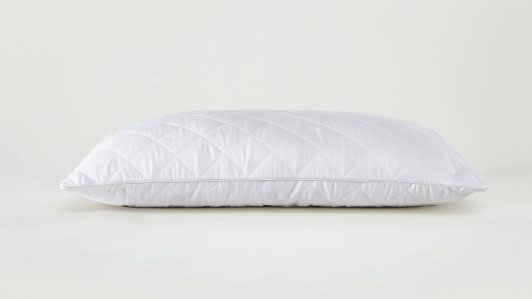
Budget-conscious shoppers seeking a high-quality pillow at an affordable price should be satisfied with the FluffBase, which pairs recycled down alternative fill with a luxuriously soft Tencel shell. Two firmness options are available, and our testing shows these designs cater to the needs of back and stomach sleepers.
Highlights
Highlights
- Recycled fill mimics the fluffiness and loft of real down
- Available in two firmness levels
- Tencel shell is soft, silky-smooth, and breathable
Ideal For
- Back and stomach sleepers
- People who are allergic to real down
- Shoppers with limited budgets
Full Details
How Does It Feel?
Why We Like It
Best Luxury Pillow
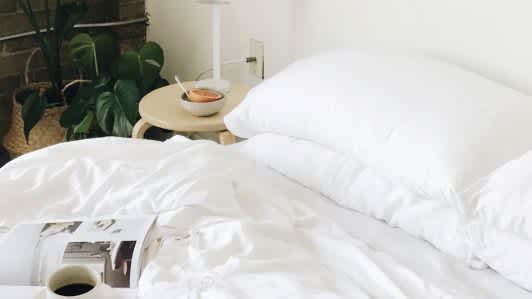
The Cozy Earth Silk Pillow was a big favorite with testers who enjoy molding and squishing their pillow. The bamboo-derived shell also makes for a cool, silky feel.
Highlights
Highlights
- Breathable bamboo-derived viscose cover
- Mulberry silk fill has a supple and airy feel
- An easily moldable design
Ideal For
- Sleepers who tend to sweat at night
- Shoppers who value sustainable materials
- People who prefer snuggling with their pillows at night
Full Details
How Does It Feel?
Why We Like It
Best Pillow for Side Sleepers

We recommend the Layla Kapok Pillow for anyone who loves the deep contouring of foam but often finds it too hot. This model runs cooler than other foam pillows we’ve tested, thanks to the blend of kapok fibers and the shredded design.
Highlights
Highlights
- Memory foam and kapok fibers for balanced support
- Copper infusions in the cover are intended to remove excess heat
- Adjustable loft to fit different sleep styles
Ideal For
- People who tend to sleep hot
- Eco-conscious shoppers
- Those who enjoy a balance of plushness and support
Full Details
How Does It Feel?
Why We Like It
Best Pillow for Neck Pain
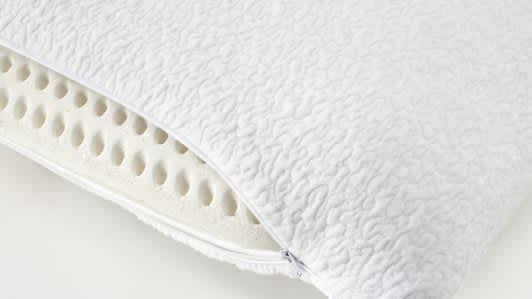
Sijo’s CloudSupport Pillow excels at relieving neck and shoulder pain with a solid latex core that feels ultra-supportive and responds to movement with a light bounce. The latex is also ventilated to promote ample airflow and help the pillow keep cool – a major plus for hot sleepers.
Highlights
Highlights
- Excellent support and responsiveness to movement
- Solid latex core recovers shape without fluffing or primping
- Excellent airflow and cooling cover help to promote temperature control
Ideal For
- Hot sleepers
- People with frequent neck or shoulder pain
- Value seekers
Full Details
How Does It Feel?
Why We Like It
Best Cooling Pillow
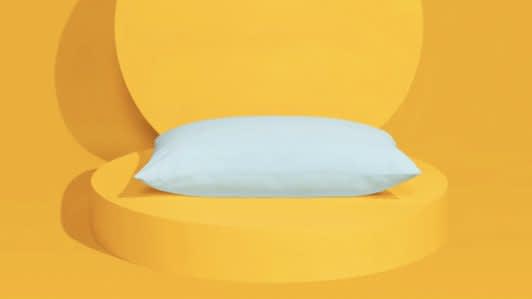
The Slumber Cloud UltraCool Pillow lives up to its name thanks to a cover made of Outlast, a revolutionary fabric engineered to capture and release body heat on contact. Plush down alternative fill provides a cushy surface for your head and neck, and you can choose from two firmness levels based on your primary sleep position.
Highlights
Highlights
- Outlast phase change fabric feels cool to the touch at all times
- Two firmness levels available
- Down alternative fill is plush, breathable, and hypoallergenic
Ideal For
- Hot sleepers
- People who are allergic to real down
- Vegans and animal-conscious shoppers
Full Details
How Does It Feel?
Why We Like It
Best Pillow for Combination Sleepers
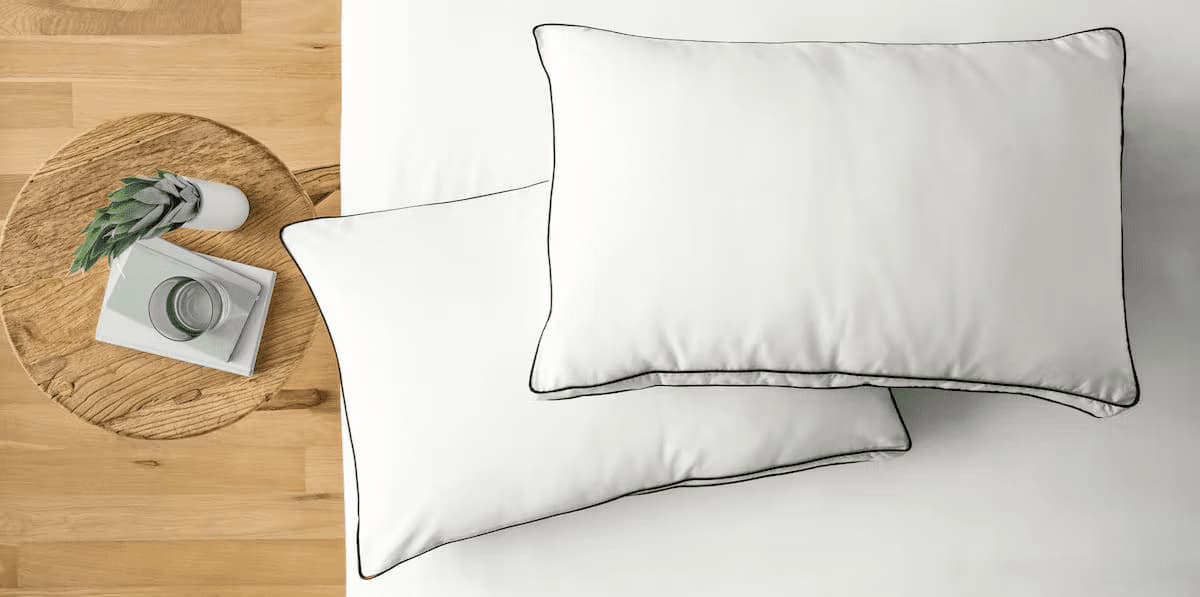
The Saatva Latex Pillow excelled in many categories during our tests, from temperature neutrality to pressure relief. The adjustable loft makes it a versatile pick for all types of sleepers.
Highlights
Highlights
- Soft and breathable organic cotton cover
- Talalay latex for a soft and springy feel
- Loft adjusts between 2 and 8 inches
Ideal For
- Side and back sleepers
- People under 230 pounds
- Those sensitive to off-gassing odors
Full Details
How Does It Feel?
Why We Like It
How We Test Pillows
We test pillows against the same set of strict standards that we use for other pillow types, but we pay close attention to several factors that set different pillows apart. In addition to firmness, conforming, and ease of cleaning, we also measure breathability. Many sleepers choose specific materials for their cool feel. To determine how well a pillow regulates temperature, we use thermal sensors that measure heat retention and we try them ourselves too, taking notes on how warm or cool we think a pillow feels after use.
There are many factors to consider when choosing a pillow, but you’ll ultimately want a pillow that feels comfortable and keeps your head, neck, and spine in healthy alignment. I recommend considering a pillow’s materials, loft, and firmness to determine if it’s a good fit for your sleep position and personal preferences.
What Are the Different Pillow Types?
Considering how much sleep preferences vary, it’s not surprising that pillows come in a variety of styles. Materials and construction methods determine key performance features like contouring, loft, and support.
In addition to standard models, there are also a number of specialty pillows designed to address the specific needs of different types of sleepers.
Fill and Materials
Fill and materials determine a pillow’s comfort and support. Each pillow type has its pros and cons, and some are better suited to certain body types and sleep styles than others.
Down and Down Alternative
Natural down consists of the fine feathers of ducks and geese and is used in a variety of bedding products. Down pillows are usually soft, breathable, and durable. However, they may aggravate allergies or asthma.
Down alternative simulates the fluffiness and malleability of natural down using polyester or other fibers. This option is suitable for vegans and those with allergies, but they tend to be less durable than natural down pillows.
Feather
Some people use feather and down interchangeably, but there’s actually a distinction between the two. Down is the soft plumage of ducks and geese, while feathers are somewhat coarser. Feather pillows typically contain a combination of feather and down for a more balanced feel.
Similar to down, feather pillows are lightweight, moldable, and breathable. They often appeal to people living in warm or humid climates because they resist heat buildup. Stomach sleepers can also benefit from their lower loft.
However, feather quills can sometimes poke through the pillow’s lining. Additionally, they tend to make more rustling noises than other pillow types.
Memory Foam
Memory foam pillows are valued for their durability and shape retention. Most consist of either solid, shredded, or cut memory foam, each resulting in a different feel. Solid designs tend to be firmer and have higher lofts. Ergonomic models commonly use solid memory foam because of its density and support. Shredded or cut pillows are often combined with other materials like microfiber clusters to create a fluffier feel.
Because memory foam tends to retain heat, this kind of pillow isn’t always the best match for people who sleep hot. However, many manufacturers use gel infusions or other cooling technologies engineered to improve temperature control.
While memory foam pillows often have higher price-points, they do tend to be more durable. That said, they also produce more off-gassing odors than natural materials like down or cotton. This is common for memory foam products, and off-gassing is generally considered harmless. However, the odor can be unpleasant if you’re particularly sensitive to smell.
Latex
Natural or synthetic latex pillows offer moderate to high contouring without trapping too much heat. Similar to memory foam, latex cores can be either solid or shredded. The feel of the pillow also depends on the type of latex used. For example, Talalay latex has a springer feel, while Dunlop offers denser support.
Latex pillows are a good option for those who like the higher density and loft of memory foam but don’t want to risk overheating. However, the higher price-points of latex pillows may be cost-prohibitive for some shoppers.
Cotton
Shoppers who prefer natural materials may want to consider cotton pillows, which are generally soft and breathable. Cotton fibers naturally wick away heat and moisture, which can help those with night sweats or hot flashes.
Cotton pillows tend to be fluffier than latex or foam models. As a result, they may lose their shape or flatten more readily. However, they can be a good fit for stomach sleepers or anyone who prefers a lower loft pillow.
Buckwheat
Filled with buckwheat hulls, these pillows have a grainy texture that contours to the sleeper. Buckwheat pillows typically deliver above-average pressure relief since they closely cradle the neck and head. They don’t trap a lot of heat, and they’re often considered a more eco-friendly alternative to other pillow types.
Buckwheat pillows may not be cushiony enough for some sleepers, though, and they tend to have higher price-points.
A pillow’s fill material is really what creates shape and moldability. The fill’s structure is important too – a shredded memory foam pillow is going to feel a lot squishier than a solid memory foam pillow.
Specialty Pillows
Shoppers can also find a range of speciality pillows to accommodate various needs.
| Type | Description |
|
Neck Pillow |
Also known as cervical pillows, these models are designed to support proper head and neck alignment. Most have a divot in the middle to elevate the neck and cradle the head. They are commonly made from dense and supportive materials like memory foam and latex. Neck pillows can alleviate pressure points by promoting better sleep posture. |
|
Body Pillow |
These large pillows are at least 48 inches long and are meant to be cuddled. Most are elongated rectangles or horseshoe-shaped. Firmness and contouring depend on the materials, but many use shredded memory foam or down alternative clusters. Some models are intended to alleviate pressure points by encouraging better spine alignment. Other sleepers simply find it comforting to hug a large pillow. |
|
Wedge Pillow |
This triangle-shaped pillow is designed to alleviate certain health and orthopedic conditions by elevating body parts. Placing the pillow below the knees can improve leg circulation and speed the recovery process for sports injuries. Wedge pillows can also sometimes help with snoring, sleep apnea, and congestion-related allergies when used as a head pillow. Additionally, some people use wedges as bolsters when sitting up in bed to read or watch TV. |
|
Knee Pillow |
These compact pillows are meant to align the spine and ease tension. Side sleepers can use them between the knees to reduce pressure on the legs and hips, while back sleepers can encourage a straighter spine by placing the pillow underneath the knees. Knee pillows are typically made from sturdy memory foam that resists sagging. Hourglass-shaped pillows are geared toward side sleepers, while wedges are more fitting for back sleepers. |
|
Pregnancy Pillow |
A pregnancy pillow is designed to make sleep more comfortable for a pregnant person’s changing body. The extra weight gained during pregnancy can put pressure on various muscles and joints, resulting in painful pressure points. A pregnancy pillow is typically an elongated C- or U-shape that contours the entire body. Placing the lower section of the pillow between the legs can help reduce pressure on the knees and spine. |
Explore More Pillow Types
Common pillow sizes tend to have similar dimensions. However, decorative and other specialty pillows come in a range of shapes and sizes.
| Size | Dimensions (Width x Length) | Description |
|
Standard |
20” x 26” |
This is the smallest of the common pillow sizes and arguably the most versatile. A twin bed comfortably fits one standard pillow, while larger beds can hold two. Standard pillows work with any sleep position, though people who frequently toss and turn may prefer a larger size. |
|
Queen |
20” x 30” |
The extra length on a queen pillow gives you more room to sprawl out. People who only use one pillow might appreciate the added surface area. One queen pillow fits nicely on a twin bed, while two pillows work well on all other bed sizes. |
|
King |
20” x 36” |
King pillows are the same width as standard and queen sizes but are longer than both. A king pillow takes up most of a twin bed’s width but can still fit. Two king pillows can sometimes feel cramped on full or queen beds. The more generous size can add extra support when you’re sitting up in bed. However, king size pillowcases aren’t always easy to find, so you may have fewer designs to choose from. |
|
Euro |
26” x 26”, 24” x 24”, 22” x 22”, 20” x 20”, 18” x 18”, 16” x 16″ |
These square-shaped pillows are available in a variety of sizes. The design is widely used in Europe as a standard sleeping pillow, but less so in the U.S. Some people use them only as decorative pillows. |
|
Body |
20″ x 48″, 20″ x 54″ |
While dimensions vary for body pillows, most are at least 48 inches long. The rectangular designs are more compact than U-shaped models, which are meant to match most of the length of a person’s body. As such, they aren’t always practical for people who share small beds. |
How Much Do Pillows Cost?
Pillows range anywhere from $10 to upwards of $200, so you should be able to find a model that fits your budget. Materials and craftsmanship tend to have the most impact on price, but pillow type, size, and brand can also influence price-points.
- Size: Price generally increases with size. That said, a luxury pillow model could be three times the cost of a mid-range model of the same size. Custom sizes or specialty models tend to be pricier because they are less common.
- Type: Not all pillow types require the same construction or craftsmanship. Handcrafted, ergonomic, or more complex designs typically command higher price-points than standard pillows.
- Material: Material type and quality heavily influence pricing. Down, latex, and memory foam tend to drive up cost, while polyester and polyfoam models are usually more economical. Natural and organic materials can also increase price-points.
- Brand: While many shoppers are willing to spend more for brand recognition, an affordable generic model is sometimes comparable to well-known brand products that cost more. Be sure to compare different brands and models to ensure you’re getting the best deal.
How to Choose a Pillow
As with mattresses, there isn’t a perfect pillow that satisfies every sleeper. Preferences vary widely when it comes to pillow type, loft, and firmness. The best pillow for you also depends on factors like body type, sleep position, and health conditions. And because not everyone has the same budget, pricing is also a consideration.
What Should You Consider?
Shoppers should consider a variety of factors when choosing a pillow, including body type, sleep position, and health concerns.
Your Body Type
Body weight, size, and head shape all affect the way a pillow feels and performs. Sleepers under 130 pounds usually enjoy a plusher model that offers more cushioning. However, a thinner design can still feel supportive for sleepers in this weight category.
People between 130 and 230 pounds are the most versatile and can enjoy a range of lofts and firmness levels. Sleepers over 230 pounds cause pillows to compress more, so they typically require a firmer model to support that level of pressure.
Weight aside, some people simply have broader shoulders, making anything smaller than a queen or king pillow feel cramped. People with larger heads sink into their pillows more, so they usually prefer higher lofts for additional support.
Your Sleeping Position
Sleep position is a huge factor when it comes to pillow compatibility. Side sleepers tend to do best with a high loft pillow that keeps their head on the same plane as their neck and shoulders. A low to medium loft design can help maintain a straighter spine for back sleepers. Stomach sleepers usually require a thin pillow to keep their head from straining upwards.
Your Health Needs
A number of pillows are designed to address various health needs. Pillows that elevate the head and upper body can alleviate snoring, acid reflux, and allergies caused by nasal congestion.
Ergonomic models like wedge, knee, and body pillows can give relief to those with aches and pains by promoting proper spinal alignment. Pillows with cooling features can benefit anyone who sleeps hot. And people with allergies might want to consider a model that’s been treated to resist the growth of bacteria, dust, mold, and other allergy triggers.
Your Budget
While higher-quality pillows tend to have higher price-points, there are options to fit just about any budget. Still, a smaller budget will somewhat limit choices, potentially excluding pricier models like latex, memory foam, or down.
Many companies offer free shipping, which can help with budgeting, but it’s always wise to check for price minimums and other exclusions.
What to Look for in a Pillow
Certain pillow qualities have a bigger impact on comfort and support than others.
Type and Material
The type and quality of materials used determines the feel and function of a pillow. Down, cotton, and microfiber clusters yield a fluffier pillow, while memory foam and latex models have more structure.
Pillows made with synthetic materials are sometimes less breathable and durable than their natural counterparts. If you have allergies, you should approach latex and down models with caution.
Height or Loft
A pillow’s relative thickness is critical for support and proper spine alignment. Each sleep position has different loft needs in order to reinforce good sleep posture. Body weight and frame also influence loft preferences.
Low loft pillows are typically less than 3 inches thick. Medium loft designs are between 3 and 5 inches, while high loft pillows are taller.
Loft makes a big difference in terms of spinal support. If you use a low-loft pillow while sleeping on your side, your neck’s going to bend in order to make contact with the pillow. The same goes for stomach sleeping with a pillow that’s too thick – you may wake up with neck stiffness.
Firmness
Firmness indicates a pillow’s feel and relative support. Softer pillows allow the head and shoulders to sink more than firmer models.
Special Features
Some pillows boast special features to enhance comfort. If you tend to overheat at night, you might want to consider pillows with gel infusions, open-cell foam, copper fibers, and other cooling technologies. If you have allergies or asthma, you may benefit from pillows with antimicrobial treatments. Materials like latex and cotton can also help, as they naturally resist allergen triggers.
Adjustable designs allow you to modify the loft of your pillow by changing the amount of fill. These pillows are good for people who like to experiment with different heights and feels.
Get the Most Out of Your Pillow
It’s important to take good care of your pillow and use it correctly in order to get the best performance out of it.
Support Your Sleep Position
Support refers to how well a pillow keeps the head and neck in optimal alignment. Good sleep posture is key to avoiding aches and pains the next morning. Material type, loft, and firmness all influence relative support.
Different body types have varying support needs. Heavier sleepers generally require more supportive pillows to keep a pillow from flattening too much.
Where you place a pillow to promote good posture is also important. The best option for you depends on your sleep position.
| Sleeping Position | Where to Place Your Pillow |
|
Side |
Between the knees. This helps straighten the spine while alleviating pressure points on the knees and hips |
|
Back |
Under the knees or lumbar area. This reduces strain on the lower back and helps maintain the spine’s natural curve. |
|
Stomach |
Under the hips or ribcage. This raises the hips and stomach, which minimizes pressure along the spine. |
Read the Care Instructions
Every pillow has different care guidelines based on its materials and construction. It’s best to follow the manufacturer’s instructions to prolong your pillow’s lifespan.
Some covers are removable and machine-washable, while others should only be spot treated. You may also be able to wash the core, but this often shortens a pillow’s lifespan.
Know When to Replace Your Pillow
How long a pillow lasts will vary based on material quality, craftsmanship, and use. Most pillows hold up for several years but start losing their shape and loft beyond this time frame. That’s why it’s important to keep an eye out for indicators that your pillow needs to be replaced.
- Irregular clumping or deep impressions: If a pillow’s fill starts to clump or bunch, then you’re probably not getting the uniform support you need. Memory foam pillows with deep indentations or impressions are likely past their prime.
- Your pillow smells: If you notice unpleasant odors despite regular cleaning, it’s time for a new pillow.
- You have aches and pains in the morning: Waking up with a stiff neck or shoulders can indicate a pillow that is no longer offering you optimal support.
- You’ve changed your sleep style: If you’ve switched your sleep position, you may need a new pillow with a different firmness level or loft.
Boost Your Pillow’s Lifespan
You can extend your pillow’s life by regularly washing pillowcases and, if applicable, the cover. Protectors can also safeguard against bacteria, mold, and mildew, which can degrade a pillow at a faster rate.
Above all, the best method for increasing your pillow’s lifespan is to follow the manufacturer’s cleaning guidelines.
